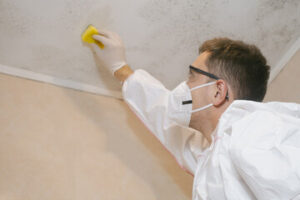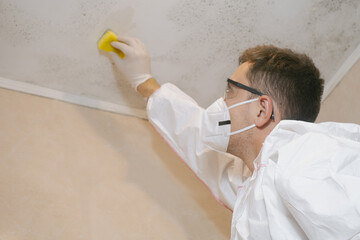You have probably experienced prolonged mold exposure at one time or another — whether in your home, your office, a friend’s house, or a vacation cabin.
Mold spores can cause a variety of negative symptoms, including respiratory problems, skin irritation, and allergic reactions. To avoid these issues, take preventive measures to control mold growth in your home. Contact Mold Removal Salt Lake City for professional help.
Mold requires oxygen, moisture and food (wood, paper and certain glues found in building materials). It is impossible to prevent the spores from entering your home, but you can take steps to control the growth of mold once it takes hold. Mold thrives in areas with high humidity levels, so keeping indoor humidity below 60% is one of the most effective ways to prevent mold growth. Regularly inspecting your building with a moisture meter can help you detect hidden dampness and address it before it becomes a problem.
Another important step in preventing mold is to clean your home regularly and to make sure that all surfaces are properly dry after water intrusion or flooding events. Leaking roofs, windows and pipes should be repaired immediately to minimize the risk of mold.
It is also a good idea to avoid using wood or drywall in humid or warm areas, as they can absorb and retain moisture which contributes to mold growth. Instead, use materials that are better suited to these environments, such as ceramic tile, drywall or concrete.
Excessive mold growth can result in structural damage to a building, including sagging floors, warped walls and even the collapse of a ceiling. It can also compromise the safety and integrity of a building by breaking down organic materials such as wood and drywall, and destroying insulation. In addition, some varieties of mold are toxic and pose a health risk to occupants.
If you notice any signs of mold, it is important to contact a professional remediation company as soon as possible. They will contain the affected area, remove and clean the affected surfaces and then treat the area with a fungicidal solution to kill any remaining spores.
Exposure to mold spores can cause a variety of symptoms, including headaches, fatigue, irritated eyes and lungs, and itchy skin. These symptoms can become more serious in individuals with preexisting conditions such as allergies, asthma or a compromised immune system.
Identifying the Source of the Moisture
Mold thrives in dark, moist places, and it can be difficult to remove from hidden spots in your home. However, you can take steps to prevent it from re-growing in these areas, by identifying and correcting the source of moisture that led to its growth.
Often, mold appears as dark spots on walls and other surfaces. It can also emit a musty odor. If you notice any of these signs, it is important to take action right away. Left untreated, it can reappear and lead to health problems for people with allergies, asthma, or weakened immune systems.
There are a variety of ways to identify the source of the mold, such as checking for water damage, looking for areas with excessive condensation or finding signs of roof leaks. If you suspect that the mold is caused by a leak, it is important to repair this as soon as possible. This can help prevent further damage to your property and limit the spread of mold.
While the mold itself can be cleaned easily, it is important to clean up the entire area, including areas where it has not grown yet. This will ensure that the spores are completely removed and that the area is safe for re-occupation. You can use a number of different cleaning methods, depending on the type and location of the mold.
Some cleaning methods are easy and affordable, while others require a bit more work but provide a longer-term solution. For example, baking soda can be used as a mold killer and works well on both hard and soft surfaces. It can be mixed with water to create a paste, applied to the affected areas and then scrubbed away. Another effective cleaner is borax, which can kill the mold without leaving toxic residues. However, it is dangerous to inhale, so it must be used with caution.
Before you begin cleaning, it is a good idea to protect yourself from the mold spores by wearing gloves, goggles and a mask. You may also want to open a few windows for ventilation and cover any surfaces that you cannot afford to damage with plastic sheets. Once you have done this, it is a good idea to mist the area with a dehumidifier or fan to help it dry out.
Cleaning the Area
Once the source of the mold has been removed, it’s time to clean the affected area. Use a specialized cleaning product or bleach, and follow the instructions on the label. You should always wear protective gear, such as a mask, gloves, and goggles, when working with any kind of cleaning solution. It’s important to completely clean the area, as mold spores can linger on surfaces even after the mold has been removed.
Be sure to wash your hands after completing the cleaning process, as mold spores can be transferred from person to person via hand contact. After the cleanup, it’s also important to re-inspect the area to ensure that all areas are free of mold and moisture.
If the mold is severe, it may be necessary to hire a professional cleaning company. These professionals are trained to identify and remove mold, as well as prevent future mold growth.
After the area has been cleaned, it is important to dry the space as quickly as possible. This can be done by using fans and dehumidifiers. It’s also important to keep humidity levels low throughout the house, especially in crawl spaces and basements.
Some items, such as rugs and clothing, may be too heavily contaminated with mold to save. Be sure to double-bag and dispose of these items correctly.
In addition to the above, it’s important to wipe down all hard surfaces with a damp cloth. This includes floors, walls, and ceilings. It’s also a good idea to wipe down all wood and metal surfaces with a fungicide. This can be purchased from any hardware store or home improvement center.
It’s also a good idea to remove any furniture, rugs, or curtains from the affected area. These items can often contain mold spores, which can spread the mold to other parts of the house. Be sure to carefully bag and dispose of all contaminated materials. It’s also a good idea for people who have respiratory issues or other health concerns to stay away from the affected area. This is because mold spores can cause respiratory distress and other health problems.
Sealing the Area
Once the mold has been cleaned, it’s time to seal the area. This is important to keep the spores from spreading to other areas and to ensure that no moisture remains in the material once it’s been cleaned. If the item is made from plastic, use a silicone sealant. This sealant is flexible, meaning it won’t damage the material and it also won’t allow any moisture to seep back in to the material. This is an essential step for items like window sills, ductwork, and air conditioning vents.
It is possible to do some level of mold remediation on your own, especially with the right cleaning supplies and techniques. However, larger issues may require specialized equipment that only professionals will have access to. They can also help you determine the cause of the problem, which is vital to preventing future problems.
Cleaning the area begins with identifying the type of mold and determining where it is located in the structure. Mold can be found in a variety of surfaces, including wood and drywall. Surface mold can be removed with a scrub brush and cleaning solution, though some porous materials will need to be cut away and replaced.
If the mold is in a non-porous surface, simply spray the cleaning solution and let it sit for about 10-15 minutes to loosen the material. It is then easy to scrub the material and rinse it off. It is important to wipe down the entire surface with clean water after scrubbing and to dry the area thoroughly to prevent moisture from hanging around and encouraging new growth.
For porous materials like drywall and wood, it is best to have a professional perform the cleaning. They can use antimicrobial cleaning products that penetrate the surface of the material and remove hidden spores. It is also possible to clean these materials using a HEPA filtered negative air machine. This draws the spores away from the building and exhausts them outside through tubing or a duct system, keeping them from being dispersed throughout the structure.
Once the area has been cleaned and sealed, it is important to monitor the material on a regular basis. If it is still contaminated, repeat the process as necessary. It is also a good idea to monitor the airflow in the area and control humidity levels with fans and dehumidifiers.
